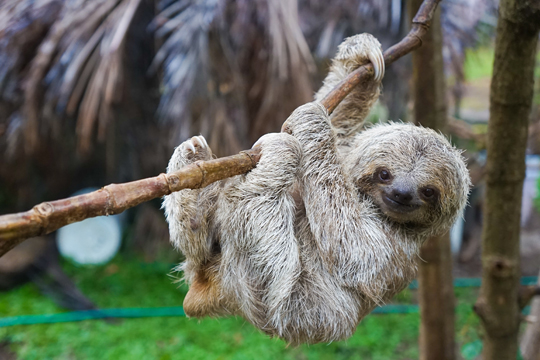Sites of Stillness
Freiburg, Sep 17, 2019
In today's turbulent times, it may be that otium is likely a research focus because the value of slowing down and being mindful is more strongly felt. Since 2013, researchers from a range of faculties have been working within the University of Freiburg's collaborative research center (CRC), "Otium. Boundaries, Chronotopes, Practices," to investigate the world of idleness. Now there is an interactive map of the world indicating sites of otium. Anyone interested can contribute to it, using words and images to describe their own, very personal place where they hang out.

Just hanging out: The sloth is the totemic animal of the journal published by the collaborative research center. Photo: Jordan/stock.adobe.com
Architect and photographer Martina Issler seeks out the "bustle" of a noisy district near Tahrir Square in Cairo, where she takes a "really deep belly breath." The Berlin-based art historian Ana Nenadovic achieves inner peace when she involuntarily "lets her feet lead her," through a lively area of Havana, Cuba. "I let myself drift, without being driven," is how Berlin sociologist Hans-Albert Wulf experienced hours of rest at a watering hole during a camel ride through the Libyan desert. He writes, in the wadi, the "Tuareg and camels are our teachers." Wulf says he can actually feel how "annoying, roaming, shreds of thought and the tiresome burden of rubbish information are rinsed from the mind." And near the small, eastern French town of Cluny, Christian Hanser has set up a "cultural center for the art of pausing," – complete with hammocks and chairs on two levels. "People come in order to do nothing," he says.
Real life and empirical
These and other descriptions can be read on the interactive website "Places of Otium – Worldwide." Many people who work in research or other fields were invited to describe their personal place to hang out. The website gives an idea of how the authors individually comprehend and experience otium and the places they associate with it. These real and personally characterized perspectives on the topic of otium are linked to the work of the CRC. In interviews, Freiburg's researchers present their means of access to the subject. A CRC team working with the coordinator of the research group, Dr. Tilman Kasten, manages the website. Up to now, around fifty contributions have been received and are gradually being uploaded onto the Internet. And more are coming.
Beyond contrasts
During the first phase of the CRC's work (2013-2016), the emphasis was on historical concepts of otium and gender in 19th Century Russia or in Roman epistolary literature. In the second phase of projects (2017-2020) – which in the meantime has come to involve six faculties, as well as IT Services (RZ), and the University Library (UB) – the spotlight is more on the contemporary and societal aspects of free time. The researchers are investigating current manifestations of the concept, such as the phenomena of courses in otium with the aim of self-improvement. The transfer project, the "Mußeum – Museum der Muße und Literatur Baden-Baden" ("Mußeum – Museum of Otium and Literature Baden-Baden" implements insights gained through the project in practice.
"Otium, as our CRC conceives of it, tends to get beyond contrasts – such as the contrast between work and free time and productivity and unproductivity," says Tilman Kasten. And therefore, perhaps the longing to simply lounge around can pave the way for an experience of otium. Certainly the choice of a sloth as the emblem of the journal "Muße" ("Otium") is meant to be taken with a grain of salt.
Hans-Dieter Fronz

